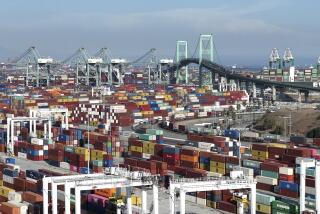Storied Brazilian Port Looms as Shipping Giant
- Share via
SAO LUIS, Brazil — People call it the curse of Itaqui--an angry spirit’s displeasure over the building of a port on this coastal island in northern Brazil.
Four men died during Itaqui’s construction, and its early years were plagued by bizarre incidents ranging from runaway train cars and phantom ships appearing at night to the sudden collapse of a 450-foot stretch of dock.
Perched on the edge of a broad estuary about 10 miles from the historic town of Sao Luis, Itaqui is surrounded by mangroves and shrouded in myths about the underwater spirit named Princess Ina.
Local mystic Jose Cupertino maintains that while laying in the port’s foundations, workers pierced Ina’s glass castle, inciting her wrath.
That’s how some here explain events like the 1985 grounding of the Hyundai New World, a 200,000-ton freighter whose captain strayed from the ship channel. The ship now rests on the bay’s floor.
Others blamed that accident on the especially strong currents in the bay, where water levels change by as much as 21 feet.
Nevertheless, the Port Authority has done its best to placate the princess. A glass-encased statue of Iemanja, a water goddess prominent in Brazilian folklore, was installed at the front of the port’s sole warehouse to protect workers in the port.
Despite all the commotion, Itaqui has grown steadily, becoming a major transit point for some of the world’s highest-quality iron ore and ever-increasing quantities of grain.
If Brazil ever realizes its potential as the colossus of South America, Itaqui will play a key role, powering development thousands of miles into the interior, port director Bento Moreira Lima Neto says.
Itaqui has “indisputable importance as one of the leading poles of economic development,” he says.
Its location and depth are key. It is Brazil’s closest deep-water port to the United States and Europe, and it boasts a minimum draft of 70 feet--second only to the busy port of Rotterdam in the Netherlands.
In a country where 60% of cargo is shipped by road, strapping Brazil with one of the world’s highest freight costs, Itaqui offers an alternative route linking the interior with the world via rail, river and sea.
The Sao Marcos Bay Port Complex--Itaqui and the two neighboring terminals of Ponta de Madeira and Alumar--handled 52 million tons of cargo in 1999: 100 times Itaqui’s tonnage when it opened in 1973.
Itaqui now ranks sixth among Brazilian ports, but Moreira hopes a spending bill before Brazil’s congress could move it up. The plan calls for a $9.5-million Itaqui appropriation, part of which would finance a 25-ton crane to augment the port’s eight smaller cranes, which move 10 million tons of break-bulk cargo a year.
Moreira wants to double that by 2005. “A 25-ton crane could move 500 tons of fertilizer an hour,” he said, referring to the port’s second largest import after petroleum products. “That means 15,000 tons a day all by itself,” six times current tonnage.
That, in turn, could mean bumper crops in the soybean fields around Balsas in southern Maranhao and the cornfields of Mato Grosso state nearly 2,000 miles away. Soya exports from Itaqui increased nearly 70 times over 16 years to reach 427,000 tons in 1999, and Moreira expects to quadruple that figure by 2005.
Nearby Lies Region Loaded With Ore
The port’s greatest asset is its relative proximity to the Carajas district of resource-rich southern Para state, whose mineral wealth includes 18 billion tons of iron ore, a billion tons of nickel and sizable deposits of manganese, bauxite and gold.
A 670-mile railway running from Carajas to Sao Luis forms the stem of a transport system that reaches deep into the country’s fertile heartland.
Six times a day, a team of three locomotives pulls a 204-car train across the landscape, each car containing 100 tons of ore destined for the Ponta de Madeira terminal just north of Itaqui. With a 62% mineral content, the ore is widely considered the world’s richest and feeds steel mills on three continents.
Other signs of Itaqui’s potential:
* Pig-iron exports have increased tenfold since 1992, to 1.2 million tons in 1999.
* A $480-million iron-pellet processing plant is going up nearby to produce more than 6 million tons a year by 2002.
* Eucalyptus plantations around Santa Ines, Maranhao, are expected to export 1 million tons of cellulose by 2003.
It’s a big change for Moreira, now 61, who arrived in 1963 a year after earning his engineering degree.
His assignment was to build a port on the distant outskirts of Sao Luis, a city settled in 1612 by the French, occupied briefly by the Dutch and finally won by the Portuguese in 1644.
The city’s charming historic center joined UNESCO’s World Heritage list in 1998.
The site chosen for Itaqui was just a barren, rocky shore, he says. “There was nothing here but water”--and Princess Ina.
More to Read
Sign up for The Wild
We’ll help you find the best places to hike, bike and run, as well as the perfect silent spots for meditation and yoga.
You may occasionally receive promotional content from the Los Angeles Times.






